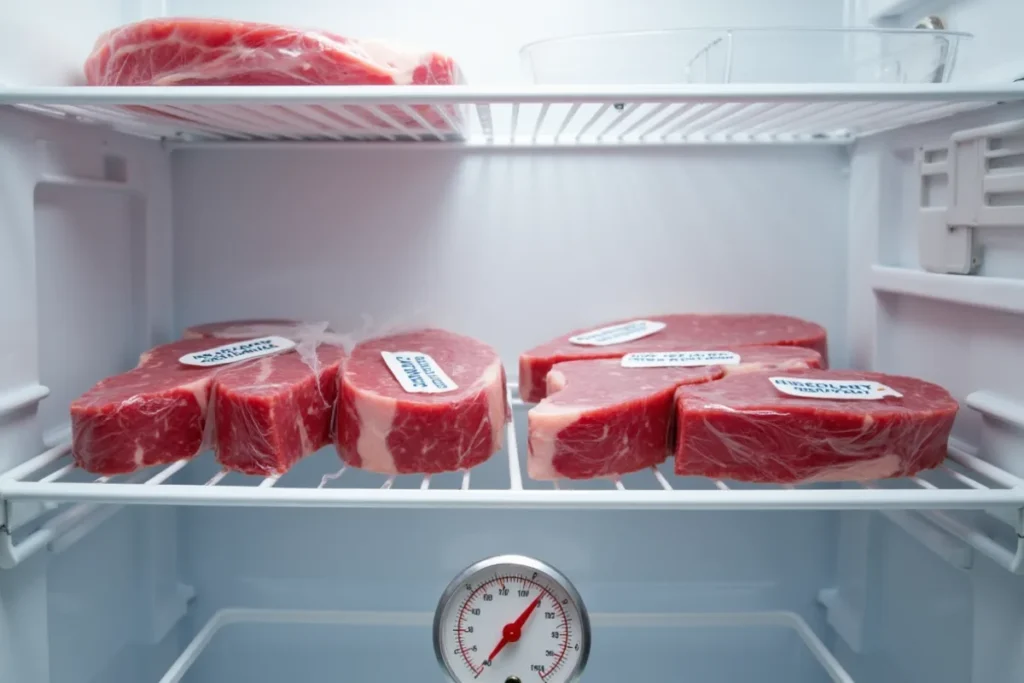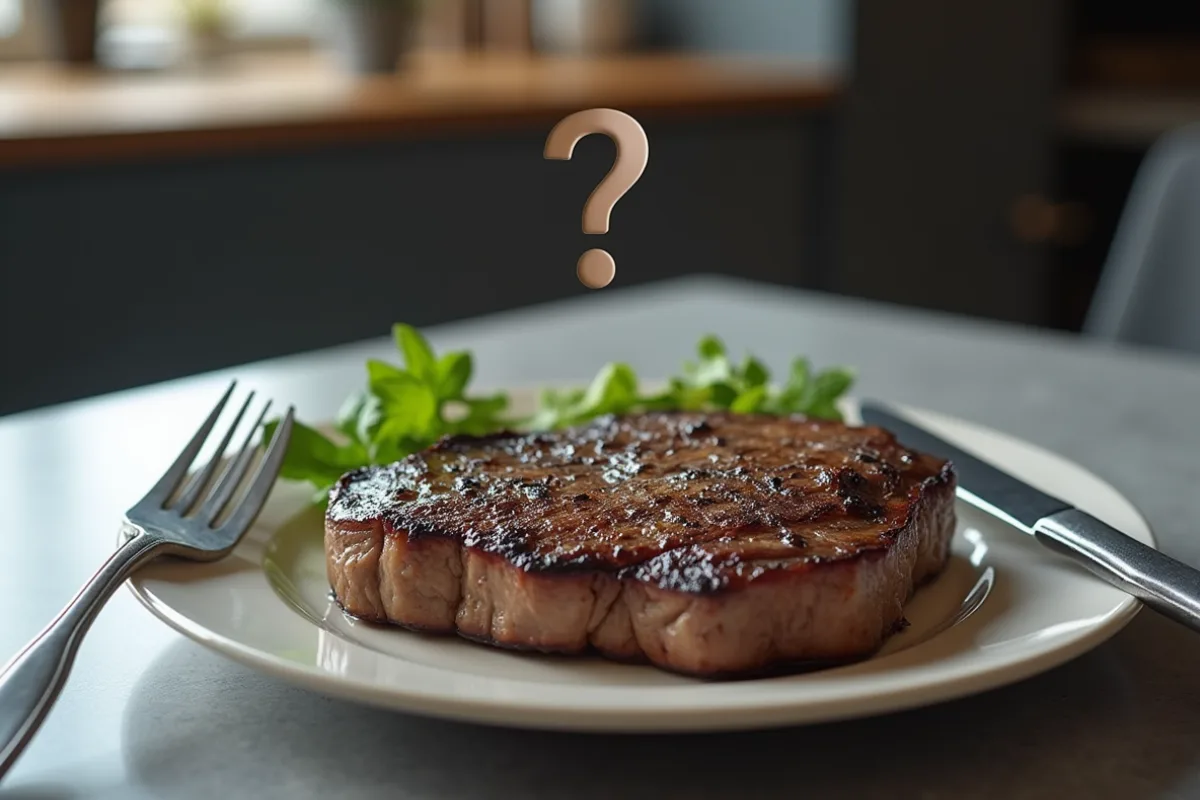Have you ever wondered, is grey steak safe to eat? This common concern arises when steak in your fridge appears less vibrant than expected. Fortunately, understanding the reasons behind these changes can help you decide whether the meat is safe to cook or should be discarded. Read on as we explore everything you need to know about grey steak.
Why Does Steak Turn Grey?
If you’ve been asking yourself, is grey steak safe to eat, the answer often depends on understanding the science behind the color change. Steak turns grey due to a lack of oxygen and the natural process of myoglobin breakdown. While it might seem alarming, these changes don’t always indicate spoilage.
Key Factors Causing Color Change:
- Oxygen Exposure: When the meat is stored for extended periods in air-permeable packaging, it loses its bright red color.
- Temperature Fluctuations: Variations in storage temperature can accelerate myoglobin breakdown.
- Prolonged Storage: Refrigeration beyond 3–5 days or improper freezing can contribute to discoloration.
Therefore, understanding these factors can help you make informed decisions about your steak.
Factors That Impact Steak Safety
When evaluating if grey steak is safe to eat, you should consider multiple factors beyond its appearance. After all, the color of the steak is just one aspect of its overall quality.
- Storage Duration: Steak typically lasts 3–5 days in the refrigerator. However, freezing can extend its shelf life for up to 12 months if done correctly.
- Packaging: Vacuum-sealed packaging limits oxygen exposure and preserves the meat’s freshness longer. Conversely, air-permeable packaging increases the likelihood of discoloration.
- Temperature Control: Maintaining a steady temperature below 40°F reduces bacterial growth and spoilage.
In short, proper handling and storage practices are crucial in maintaining steak safety.
Signs of Spoiled Steak
Grey color alone doesn’t mean your steak is bad. Nevertheless, there are other signs that indicate spoilage. Therefore, it is essential to examine these additional factors:
- Odor: A sour, rancid, or ammonia-like smell is a strong indicator that the meat has gone bad.
- Texture: Slimy, sticky, or overly dry meat should be discarded.
- Unusual Colors: Green, blue, or iridescent hues signify spoilage.
If you detect any of these signs, it’s always safer to throw the steak away rather than risk your health.
Grey Steak vs. Spoiled Steak
It’s easy to confuse grey steak with spoiled steak, but the two are not the same. In many cases, grey steak can still be fresh and safe if it smells normal, feels firm to the touch, and lacks any sticky or slimy texture. The discoloration may simply be a result of oxidation or prolonged storage.
Moreover, the color of the meat isn’t the only indicator of its quality, so you should trust your senses when deciding.
How to Safely Store Steak

If you want to prevent your steak from turning grey, proper storage is essential. By following these guidelines, you can maintain the quality of your meat for longer periods.
- Refrigeration: Place the steak in the coldest part of your fridge, ideally at a temperature between 32°F and 40°F.
- Vacuum Sealing: Invest in vacuum-sealing equipment to remove oxygen from the packaging.
- Freezing: For long-term storage, wrap steak in an airtight freezer-safe bag. Label the package with the freezing date to keep track of its shelf life.
Additionally, storing your steak correctly can significantly reduce the chances of spoilage and discoloration.
Tips for Assessing Steak Quality
Before you decide whether to cook or discard grey steak, use these simple assessment steps. By doing so, you can ensure your steak is safe and enjoyable.
- Smell It: Any unusual or unpleasant odors indicate spoilage.
- Touch It: Slimy or overly dry surfaces suggest the meat is no longer fresh.
- Check the Date: Always refer to the packaging date as a guideline.
- Visual Inspection: Greyish tones are not inherently bad but should be evaluated alongside smell and texture.
Thus, combining these factors will give you a clear understanding of the steak’s condition.
When to Discard Steak
Knowing is grey steak safe to eat often depends on recognizing the signs of spoilage. If your steak has an unpleasant odor, a sticky texture, or unusual colors like green or blue, it’s better to discard it. Otherwise, grey steak is often safe, provided it passes the smell and texture checks.
Knowing when to discard steak is crucial for your health. You should toss the meat if it has:
- A strong, off-putting smell.
- A slimy or sticky coating.
- Visible mold or discoloration beyond grey (e.g., green or blue patches).
Ultimately, when in doubt, it’s better to err on the side of caution rather than risk foodborne illness.
Cooking Grey Steak
If you’ve determined that your grey steak is safe, cooking it properly will ensure a delicious meal. Here’s a simple preparation method:
Ingredients:
| Ingredient | Quantity |
|---|---|
| Safe grey steak | 1 pound |
| Salt | 1 teaspoon |
| Black pepper | 1 teaspoon |
| Olive oil | 2 tablespoons |
Instructions:
- Heat a skillet over medium-high heat.
- Rub steak with olive oil, salt, and pepper.
- Place the steak in the skillet and sear for 3–5 minutes on each side until browned.
- Let the steak rest for a few minutes before serving.
In any case, cooking to an internal temperature of at least 145°F ensures any bacteria are killed. Furthermore, this method enhances the flavor and texture of your steak.
Does Grey Steak Taste Different?
The appearance of your steak doesn’t necessarily affect its taste. However, prolonged storage can alter its flavor slightly. Proper seasoning and cooking techniques can enhance the natural taste, ensuring a satisfying meal.
For instance, marinating the steak or adding bold spices can mask any subtle changes in flavor. Additionally, choosing high-quality ingredients ensures the best possible outcome.
The Role of Packaging in Color Changes
Different packaging methods can influence how steak appears. For example, vacuum-sealed packaging reduces oxygen exposure, which can preserve the red color for longer. On the other hand, air-permeable packaging leads to quicker oxidation and a higher chance of the steak turning grey.
For this reason, you may notice a difference in color between steaks sold in vacuum-sealed packages and those sold in traditional plastic wrap.
Can Freezing Make Steak Grey?
Yes, freezing can cause steak to lose its red color, especially if exposed to air. This is due to oxidation and freezer burn, which can result in grey patches. To avoid this, always use airtight packaging and consume frozen steak within the recommended time frame.
Furthermore, thawing meat properly by leaving it in the refrigerator overnight can prevent further discoloration. Therefore, taking these steps will help maintain your steak’s quality.
Does Grey Meat Always Mean Spoiled?
Not necessarily. Grey meat is often misunderstood as spoiled. While spoilage is possible, discoloration is a natural process that doesn’t always correlate with the meat being unsafe. Consequently, trust your senses and follow storage guidelines to differentiate between safe and spoiled steak.
Common Myths About Steak Color
There are several misconceptions about steak color:
- Myth: Only bright red steak is fresh.
- Fact: Bright red color is influenced by oxygen exposure, not necessarily freshness.
- Myth: Grey steak is always spoiled.
- Fact: Grey meat can be safe if it shows no other signs of spoilage.
Thus, understanding these myths helps you make informed decisions.
Conclusion
Grey steak isn’t something to fear. While the color change might look unappealing, it’s often a harmless result of oxidation or storage conditions. Moreover, by following proper storage and cooking practices, you can enjoy your steak without worry. Remember, always trust your senses and stay informed for a safe, delicious dining experience.

